towing HONDA CIVIC 2022 Owners Manual
[x] Cancel search | Manufacturer: HONDA, Model Year: 2022, Model line: CIVIC, Model: HONDA CIVIC 2022Pages: 700, PDF Size: 13.98 MB
Page 7 of 700
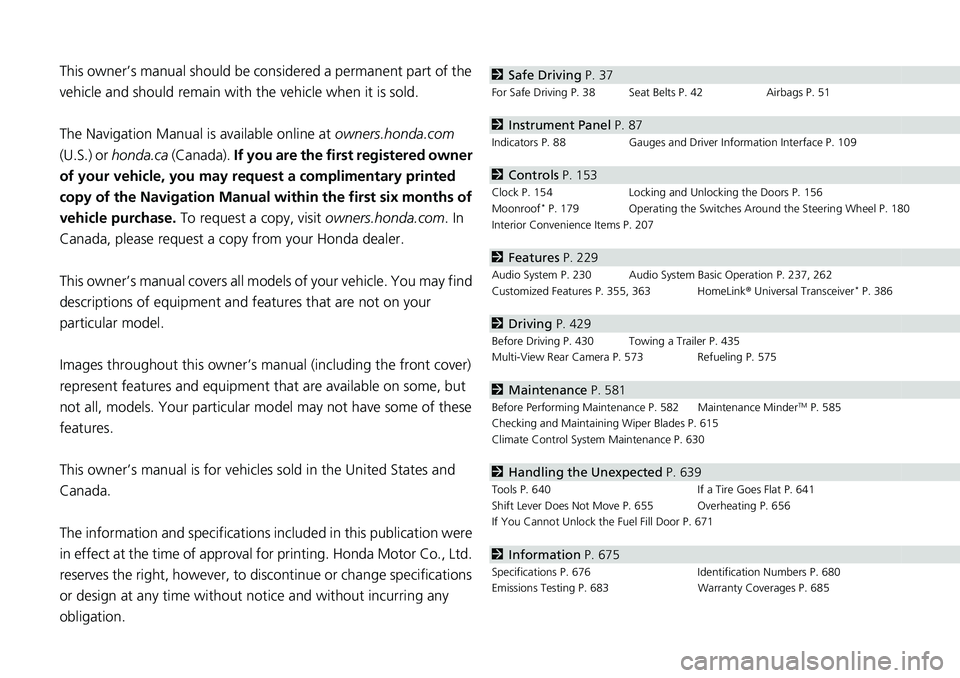
Contents
This owner’s manual should be considered a permanent part of the
vehicle and should remain with the vehicle when it is sold.
The Navigation Manual is available online at owners.honda.com
(U.S.) or honda.ca (Canada). If you are the first registered owner
of your vehicle, you may request a complimentary printed
copy of the Navigation Manual within the first six months of
vehicle purchase. To request a copy, visit owners.honda.com. In
Canada, please request a copy from your Honda dealer.
This owner’s manual covers all models of your vehicle. You may find
descriptions of equipment and features that are not on your
particular model.
Images throughout this owner’s ma nual (including the front cover)
represent features and equipment that are available on some, but
not all, models. Your particular mo del may not have some of these
features.
This owner’s manual is for vehicles sold in the United States and
Canada.
The information and specifications in cluded in this publication were
in effect at the time of approval for printing. Honda Motor Co., Ltd.
reserves the right, however, to discontinue or change specifications
or design at any time without notice and without incurring any
obligation.2 Safe Driving P. 37
For Safe Driving P. 38 Seat Belts P. 42 Airbags P. 51
2Instrument Panel P. 87
Indicators P. 88 Gauges and Driver Information Interface P. 109
2Controls P. 153
Clock P. 154 Locking and Unlocking the Doors P. 156
Moonroof* P. 179 Operating the Switches Around the Steering Wheel P. 180
Interior Convenience Items P. 207
2 Features P. 229
Audio System P. 230 Audio System Basic Operation P. 237, 262
Customized Features P. 355, 363 HomeLink ® Universal Transceiver* P. 386
2 Driving P. 429
Before Driving P. 430 Towing a Trailer P. 435
Multi-View Rear Camera P. 573 Refueling P. 575
2Maintenance P. 581
Before Performing Maintenance P. 582 Maintenance MinderTM P. 585
Checking and Maintaining Wiper Blades P. 615
Climate Control System Maintenance P. 630
2Handling the Unexpected P. 639
Tools P. 640 If a Tire Goes Flat P. 641
Shift Lever Does Not Move P. 655 Overheating P. 656
If You Cannot Unlock the Fuel Fill Door P. 671
2 Information P. 675
Specifications P. 676 Identification Numbers P. 680
Emissions Testing P. 683 Warranty Coverages P. 685
Page 8 of 700
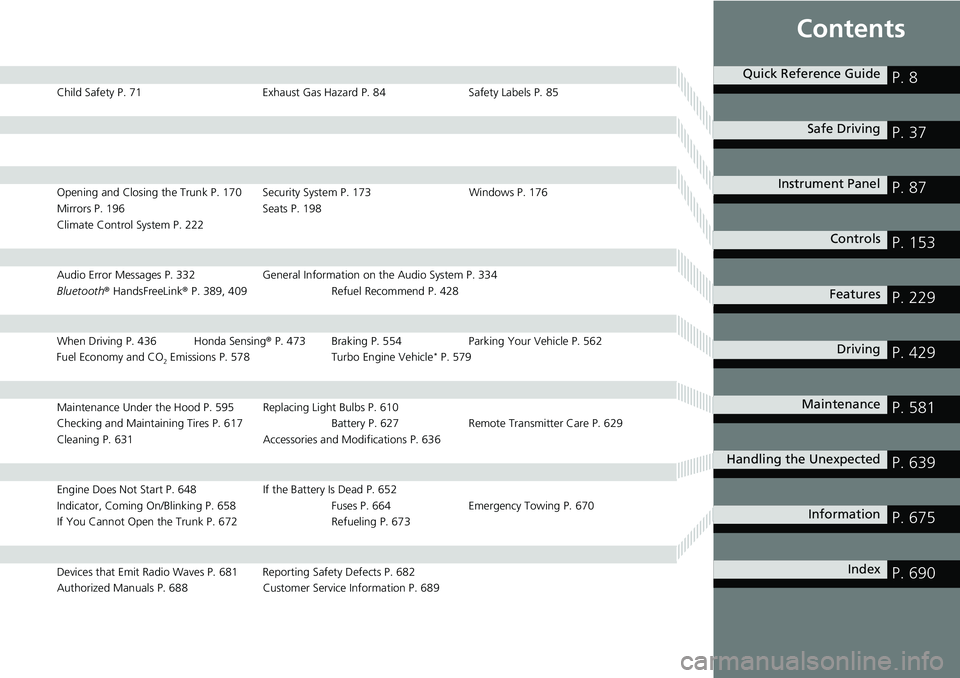
Contents
Child Safety P. 71Exhaust Gas Hazard P. 84Safety Labels P. 85
Opening and Closing the Trunk P. 170 Security System P. 173 Windows P. 176
Mirrors P. 196 Seats P. 198
Climate Control System P. 222
Audio Error Messages P. 332 General Information on the Audio System P. 334
Bluetooth ® HandsFreeLink ® P. 389, 409 Refuel Recommend P. 428
When Driving P. 436 Honda Sensing ® P. 473 Braking P. 554 Parki ng Your Vehicle P. 562
Fuel Economy and CO
2 Emissions P. 578 Turbo Engine Vehicle* P. 579
Maintenance Under the Hood P. 595 Replacing Light Bulbs P. 610
Checking and Maintaining Tires P. 617 Batt ery P. 627 Remote Transmitter Care P. 629
Cleaning P. 631 Accessories and Modifications P. 636
Engine Does Not Start P. 648 If the Battery Is Dead P. 652
Indicator, Coming On/Blinking P. 658 Fuses P. 664Emergency Towing P. 670
If You Cannot Open the Trunk P. 672 Refueling P. 673
Devices that Emit Radio Waves P. 681 Reporting Safety Defects P. 682
Authorized Manuals P. 688 Customer Service Information P. 689
Quick Reference GuideP. 8
Safe DrivingP. 37
Instrument PanelP. 87
ControlsP. 153
FeaturesP. 229
DrivingP. 429
MaintenanceP. 581
Handling the UnexpectedP. 639
InformationP. 675
IndexP. 690
Page 33 of 700
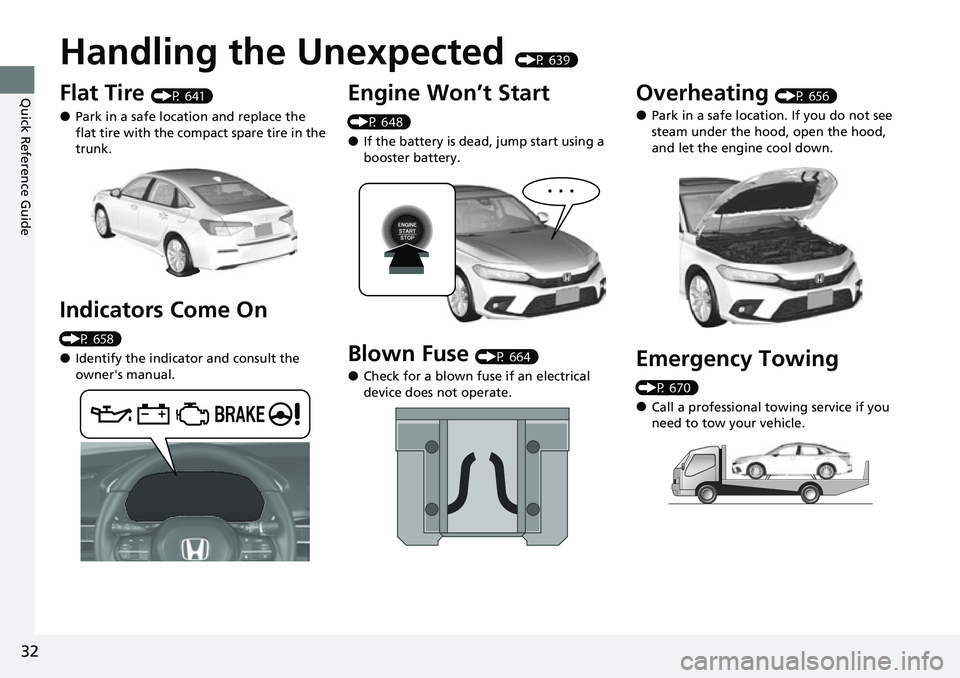
32
Quick Reference Guide
Handling the Unexpected (P 639)
Flat Tire (P 641)
●Park in a safe location and replace the
flat tire with the compact spare tire in the
trunk.
Indicators Come On
(P 658)
●Identify the indicator and consult the
owner's manual.
Engine Won’t Start
(P 648)
●If the battery is dead, jump start using a
booster battery.
Blown Fuse (P 664)
●Check for a blown fuse if an electrical
device does not operate.
Overheating (P 656)
●Park in a safe location. If you do not see
steam under the hood, open the hood,
and let the engine cool down.
Emergency Towing
(P 670)
●Call a professional towing service if you
need to tow your vehicle.
Page 430 of 700

429
Driving
This chapter discusses driving and refueling.
Before Driving................................... 430
Towing a Trailer ................................ 435
When Driving
Starting the Engine .......................... 436
Precautions While Driving................. 441
Continuously Variable Transmission ..... 442Shifting .................................... 443, 445
ECON Button*................................. 449
Drive Mode Switch*......................... 450
Auto Idle Stop .................................. 453
Vehicle Stability AssistTM (VSA®), aka Electronic
Stability Control (ESC), System .............. 459
Agile Handling Assist ....................... 461
Tire Pressure Monitoring System (TPMS) .... 462Tire Pressure Monitoring System (TPMS) - Required Federal Explanation ......... 467
Blind Spot Information System
*....... 469
Honda Sensing ®................................ 473
Collision Mitigati on Braking System
TM
(CMBSTM) ....................................... 476
Low Speed Braking Control*............ 488
Adaptive Cruise Control (ACC) with Low
Speed Follow ................................. 494
Lane Keeping Assist System (LKAS).... 516
Traffic Jam Assist ............................. 528
Road Departure Mitigation System ... 537 Traffic Sign Recognition System ....... 545
Front Wide View Camera ................. 551
Sonar Sensors
*................................ 553
Braking
Brake System ................................... 554
Anti-lock Brake System (ABS) ........... 560
Brake Assist System ......................... 561
Parking Your Vehicle ........................ 562
Multi-View Rear Camera .................. 573
Refueling ........................................... 575
Fuel Economy and CO
2 Emissions .... 578
Turbo Engine Vehicle*...................... 579
* Not available on all models
Page 434 of 700
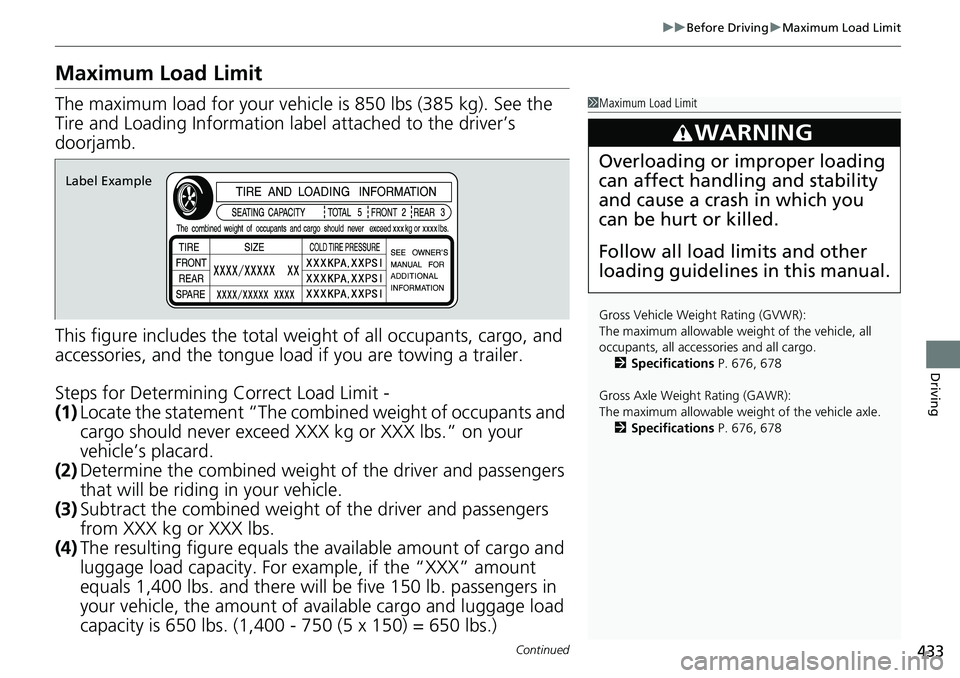
433
uuBefore Driving uMaximum Load Limit
Continued
Driving
Maximum Load Limit
The maximum load for your vehicl e is 850 lbs (385 kg). See the
Tire and Loading Information la bel attached to the driver’s
doorjamb.
This figure includes the total weig ht of all occupants, cargo, and
accessories, and the tongue load if you are towing a trailer.
Steps for Determining Correct Load Limit -
(1) Locate the statement “The combined weight of occupants and
cargo should never exceed XXX kg or XXX lbs.” on your
vehicle’s placard.
(2) Determine the combined weight of the driver and passengers
that will be riding in your vehicle.
(3) Subtract the combined weight of the driver and passengers
from XXX kg or XXX lbs.
(4) The resulting figure equals the available amount of cargo and
luggage load capacity. For example, if the “XXX” amount
equals 1,400 lbs. and there will be five 150 lb. passengers in
your vehicle, the am ount of available cargo and luggage load
capacity is 650 lbs. (1,400 - 750 (5 x 150) = 650 lbs.)1 Maximum Load Limit
Gross Vehicle Weight Rating (GVWR):
The maximum allowable weight of the vehicle, all
occupants, all accesso ries and all cargo.
2 Specifications P. 676, 678
Gross Axle Weight Rating (GAWR):
The maximum allowable weight of the vehicle axle. 2 Specifications P. 676, 678
3WARNING
Overloading or improper loading
can affect handling and stability
and cause a crash in which you
can be hurt or killed.
Follow all load limits and other
loading guidelines in this manual.
Label Example
Page 435 of 700
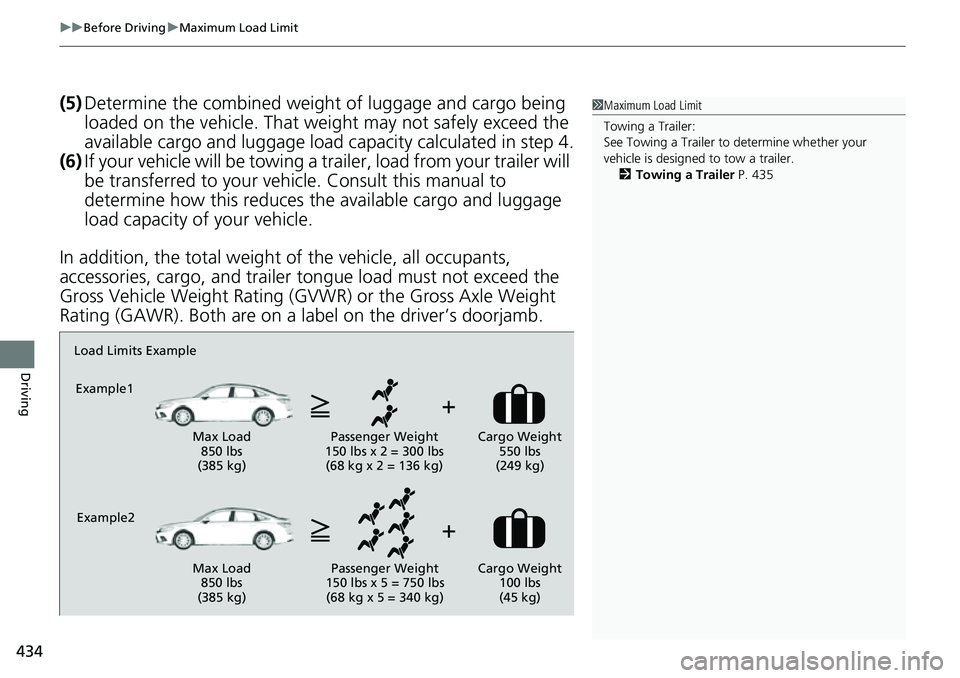
uuBefore Driving uMaximum Load Limit
434
Driving
(5) Determine the combined weight of luggage and cargo being
loaded on the vehicle. That we ight may not safely exceed the
available cargo and luggage load capacity calculated in step 4.
(6) If your vehicle will be towing a trailer, load from your trailer will
be transferred to your vehicl e. Consult this manual to
determine how this reduces the available cargo and luggage
load capacity of your vehicle.
In addition, the total weight of the vehicle, all occupants,
accessories, cargo, and trailer tongue load must not exceed the
Gross Vehicle Weight Rating (GVW R) or the Gross Axle Weight
Rating (GAWR). Both are on a label on the driver’s doorjamb.1 Maximum Load Limit
Towing a Trailer:
See Towing a Trailer to determine whether your
vehicle is designed to tow a trailer.
2 Towing a Trailer P. 435
Load Limits Example
Example1
Max Load 850 lbs
(385 kg) Passenger Weight
150 lbs x 2 = 300 lbs (68 kg x 2 = 136 kg) Cargo Weight
550 lbs
(249 kg)
Example2 Max Load 850 lbs
(385 kg) Passenger Weight
150 lbs x 5 = 750 lbs (68 kg x 5 = 340 kg) Cargo Weight
100 lbs
(45 kg)
Page 436 of 700

435
Driving
Towing a Trailer
Your vehicle is not designed to tow a trailer. Attempting to do so can void your
warranties.
Towing Behind a Motorhome
Your vehicle is not designed to be towed behind a motor home. If your vehicle needs
to be towed in an emergency, refer to the emergency towing information.
2Emergency Towing P. 670
Page 640 of 700

639
Handling the Unexpected
This chapter explains how to handle unexpected troubles.
ToolsTypes of Tools .................................. 640
If a Tire Goes Flat
Changing a Flat Tire ......................... 641
Engine Does Not Start Checking the Engine ........................ 648
If the Remote Key Battery is Weak.... 649
Emergency Engine Start ................... 650
Emergency Engine Stop ................... 651
If the Battery Is Dead Jump Starting Procedure .................. 652
Shift Lever Does Not Move .............. 655Overheating
How to Handle Overheating............. 656
Indicator, Coming On/Blinking
If the Low Oil Pressure Warning Appears ... 658If the Charging System Indicator Comes On ............................................. 659
If the Malfunction Indicator Lamp Comes
On or Blinks ................................... 659
If the Brake System Indicator (Red) Comes
On or Blinks ................................... 660
If the Brake System Indicator (Red) Comes On or Blinks at the Same Time When the Brake
System Indicator (Amber) Comes On .....661
If the Electric Power Steering (EPS) System
Indicator Comes On ....................... 662
If the Low Tire Pressure/TPMS Indicator Comes On or Blinks ....................... 663
Fuses Fuse Locations ................................. 664
Inspecting and Changing Fuses ........ 668
Emergency Towing ........................... 670
If You Cannot Unlock the Fuel Fill Door .... 671
If You Cannot Open the Trunk............672
Refueling........................................... 673
Page 642 of 700
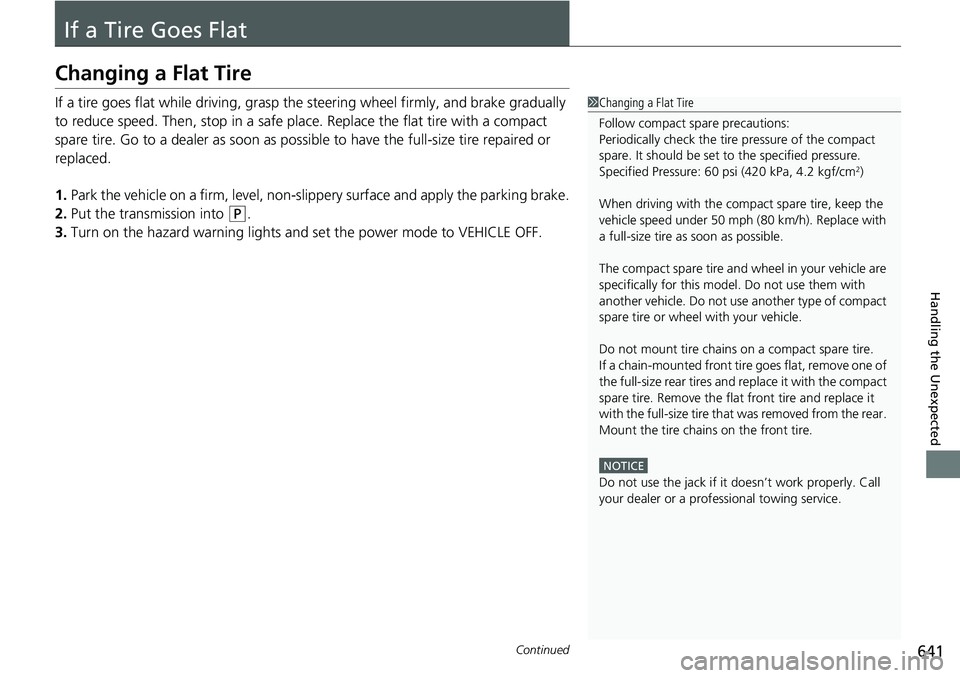
641Continued
Handling the Unexpected
If a Tire Goes Flat
Changing a Flat Tire
If a tire goes flat while driving, grasp the steering wheel firmly, and brake gradually
to reduce speed. Then, stop in a safe plac e. Replace the flat tire with a compact
spare tire. Go to a dealer as soon as possib le to have the full-size tire repaired or
replaced.
1. Park the vehicle on a firm, level, non-slippery surface and apply the parking brake.
2. Put the transmission into
(P.
3. Turn on the hazard warning lights an d set the power mode to VEHICLE OFF.
1Changing a Flat Tire
Follow compact spare precautions:
Periodically check the tire pressure of the compact
spare. It should be set to the specified pressure.
Specified Pressure: 60 psi (420 kPa, 4.2 kgf/cm
2)
When driving with the compact spare tire, keep the
vehicle speed under 50 mph (80 km/h). Replace with
a full-size tire as soon as possible.
The compact spare tire and wheel in your vehicle are
specifically for this model. Do not use them with
another vehicle. Do not us e another type of compact
spare tire or wheel with your vehicle.
Do not mount tire chains on a compact spare tire.
If a chain-mounted front tire goes flat, remove one of
the full-size rear tires and replace it with the compact
spare tire. Remove the flat front tire and replace it
with the full-size tire that was removed from the rear.
Mount the tire chains on the front tire.
NOTICE
Do not use the jack if it doesn’t work properly. Call
your dealer or a prof essional towing service.
Page 649 of 700
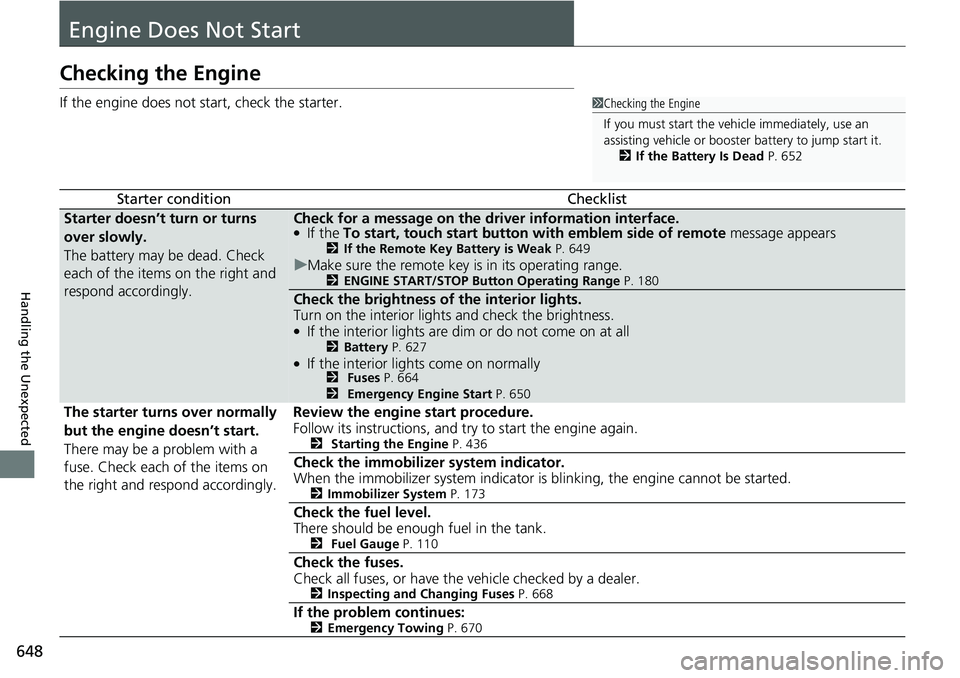
648
Handling the Unexpected
Engine Does Not Start
Checking the Engine
If the engine does not start, check the starter.
Starter conditionChecklist
Starter doesn’t turn or turns
over slowly.
The battery may be dead. Check
each of the items on the right and
respond accordingly.Check for a message on the dr iver information interface.●If the To start, touch start button with emblem side of remote message appears2If the Remote Key Battery is Weak P. 649
uMake sure the remote key is in its operating range.2 ENGINE START/STOP Button Operating Range P. 180
Check the brightness of the interior lights.
Turn on the interior light s and check the brightness.
●If the interior lights are dim or do not come on at all2Battery P. 627●If the interior lights come on normally2 Fuses P. 664
2 Emergency Engine Start P. 650
The starter turns over normally
but the engine doesn’t start.
There may be a problem with a
fuse. Check each of the items on
the right and respond accordingly. Review the engine start procedure.
Follow its instructions, and try to start the engine again.
2
Starting the Engine P. 436
Check the immobilizer system indicator.
When the immobilizer system indicator is blinking, the engine cannot be started.
2Immobilizer System P. 173
Check the fuel level.
There should be enough fuel in the tank.
2 Fuel Gauge P. 110
Check the fuses.
Check all fuses, or have the vehicle checked by a dealer.
2Inspecting and Changing Fuses P. 668
If the problem continues:2Emergency Towing P. 670
1Checking the Engine
If you must start the vehi cle immediately, use an
assisting vehicle or booster battery to jump start it.
2 If the Battery Is Dead P. 652